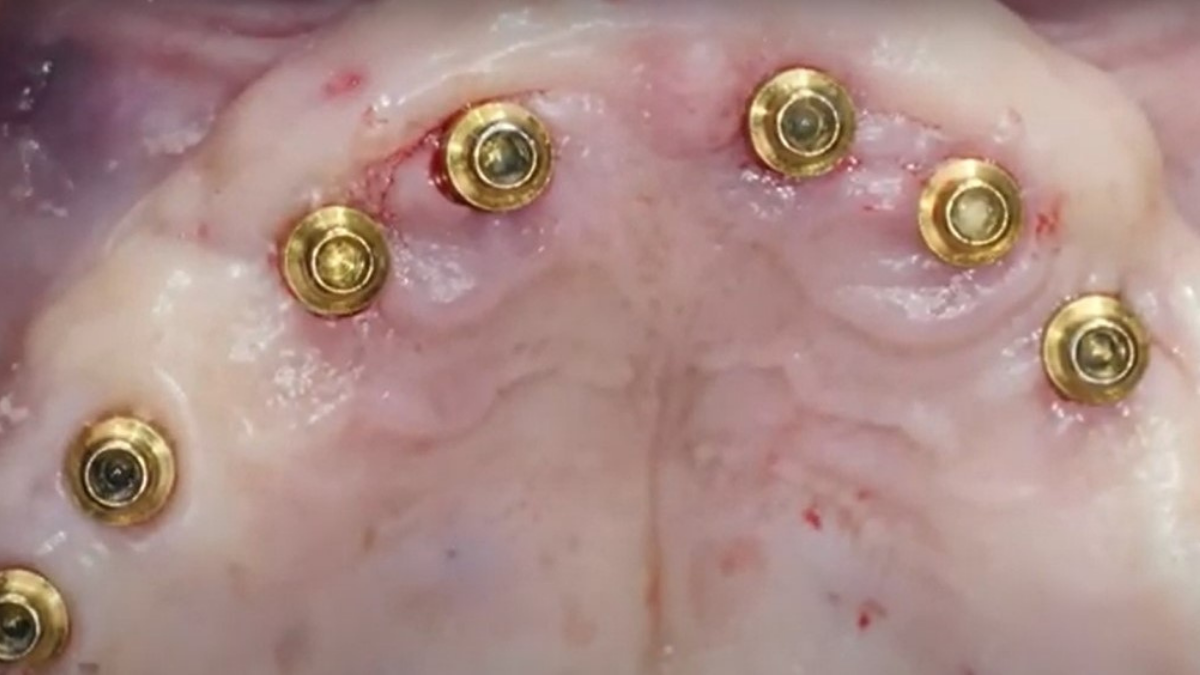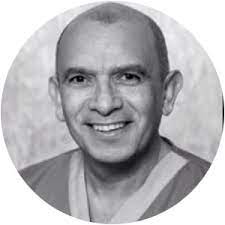Abstract
The case shows immediate loading in a patient with coronal fracture. A 33-year-old patient with tooth number 24 fractured. A CT scan revealed a chronic periapical lesion of the vestibular root. The patient was treated with a post-extraction of Alpha-Bio Tec's MultiNeO™ implant, xenograft bone regeneration, resorbable collagen membrane and non-functional immediate loading using a PEEK abutment.
Background
Tooth fractures with aesthetic alterations are situations that require efficient and predictable treatments. The post-extraction implant is an example for such a treatment. The osseointegration capacity of the MultiNeOTM implant has been previously demonstrated [1, 2, 3]. There is no significant difference between the postextraction implant and the delayed implant with regard to success rates or peri-implant tissues [4, 5]. Ideal situations have been described for the placement of these implants [6]. Implant placement is not contraindicated in teeth with chronic periapical infections, provided that they are previously curetted and treated with antibiotics [7]. Immediate loading is defined as functional or non-functional loading within 48 hours [8]. The success rate of immediate loading implants is between 96.9% and 98.99% [9, 10]. Because there is no difference between delayed loading implants and immediate loading implants, some practitioners recommend doing immediate loading [11].
It is important to avoid micro-movements during the healing phase [12, 13] which is why we do non-functional immediate loading. The basic requirement for immediate loading is the primary stability of the implant, which depends on the design of the implant, bone quality and milling [14]. The post-extraction immediate loading implant is a procedure that is well documented in the literature.
Immediate Loading Protocol: Clinical Considerations
Immediate loading dental implants in extraction sites with active periapical disease represents a significant clinical challenge in contemporary implant dentistry. This case demonstrates successful immediate implant placement following extraction of a single tooth (#24) with chronic periapical lesion affecting the vestibular root—a clinical scenario requiring careful treatment planning and precise surgical technique.
The treatment procedures performed in this case included atraumatic tooth extraction, thorough surgical curettage of the periapical lesion through a vestibular fold approach to prevent vertical shocks, immediate implant placement, xenograft bone regeneration, placement of resorbable collagen membrane, and non-functional immediate loading with occlusion control. All procedures were completed in a single visit, demonstrating the advantages of streamlined immediate loading protocols for patients requiring aesthetic solutions in visible zones.
Primary stability achieved through appropriate implant design and insertion technique is essential for immediate loading success. The MultiNeO™ implant system's design features enabled sufficient mechanical engagement despite the compromised bone quality at the site with pre-existing disease. This primary stability made possible the immediate placement of a provisional prosthesis, addressing the patient's aesthetic concerns while allowing biological healing processes to proceed undisturbed.
Bone regeneration management in infected extraction sites requires specific clinical considerations. Published studies referenced in this article demonstrate that immediate implant placement in teeth with chronic periapical infections achieves predictable results when proper surgical curettage and antibiotic management are performed [7]. The guided bone regeneration technique using xenograft material and resorbable membrane addressed both the periapical bone defect and extraction socket gaps, creating sufficient bone volume for long-term implant stability. This simultaneous bone regeneration approach, compared to delayed grafting protocols, reduced overall treatment time from multiple months to a single surgical visit.
Prosthetic management strategies significantly impact immediate loading outcomes. This case employed non-functional immediate loading—the PEEK abutment prosthesis provided aesthetic restoration while strict occlusion relief protected the implant during the critical healing phase. This prosthetic technique represents a conservative approach that balances patient aesthetic demands with biological requirements for undisturbed osseointegration. The provisional crown design eliminated functional forces while maintaining soft tissue architecture in the aesthetic region, demonstrating how prosthetic solutions can achieve both clinical and aesthetic outcomes in immediate loading protocols.
Clinical factors influencing immediate loading success in compromised sites include adequate surgical access, thorough disease management, appropriate implant system selection, controlled prosthetic loading, and patient compliance with post-operative care protocols. The treatment planning for such cases must integrate these multiple factors to achieve predictable clinical outcomes. Published information and clinical experience both recommend this systematic approach for immediate loading dental implants in extraction sites with periapical pathology.
The benefits of immediate loading protocols, when proper case selection and technique are applied, include reduced treatment duration, elimination of removable prosthesis solutions, maintained soft tissue contours, and improved patient experience and satisfaction. This case demonstrates that immediate implant placement with simultaneous bone regeneration and non-functional loading can deliver predictable aesthetic and functional results even in challenging clinical scenarios with pre-existing bone disease.
The article provides clinical information demonstrating how different treatment considerations—surgical procedures, bone management, prosthetic design, and occlusion control—must be integrated for successful immediate loading outcomes. For practitioners evaluating immediate loading protocols in aesthetic zones with compromised bone quality, this case offers significant clinical insights into achieving predictable results through systematic treatment planning and execution.
Case Overview
A 33-year old female patient came for a consultation due to a tooth fracture, requesting a dental implant that has, if possible, a base without palatal coverage. The patient smokes 10 cigarettes per day. No medical history was reported. Extra-oral inspection: Mouth opening of 45mm. High smile line and normal ATM. Normal mastication muscles. Intra oral inspection: Tongue, palate and floor of the mouth are normal. Normal salivation. Normal palate anatomy. Thin gingival biotype. No periodontal disease. Maxilla: Residual root of tooth number 16, coronal fracture of tooth number 24, cavities in numbers 25 and 26, and wear facets on numbers 11 and 21. Fracture of the distal radius of tooth number 22. Mandible: Fillings in 37 and 46. Residual rot of 36. Cavities on the vestibular surface of 34.
Radiographic findings Orthopantomogram: Residual rot was observed in numbers 15 and 36. Coronal fracture of tooth number 24 with radiolucency in the periapical area. CT Scan: Periapical lesion of the vestibular root of tooth number 24 with bone loss was observed at this level.
Materials Used X-ray 3.75 X 13mm MultiNeOTM Implant (Alpha-Bio Tec) PEEK Abutment H 1.0
Treatment Plan
In response to the demands of the patient, who asked for a quick and aesthetic solution for the fracture of tooth number 24, we proceeded to do the following: Surgical Phase It is important to avoid micro-movements during the healing phase [12, 13] which is why we do non-functional immediate loading. The basic requirement for immediate loading is the primary stability of the implant, which depends on the design of the implant, bone quality and milling [14]. The post-extraction immediate loading implant is a procedure that is well documented in the literature. Radiographic findings Orthopantomogram: Residual rot was observed in numbers 15 and 36. Coronal fracture of tooth number 24 with radiolucency in the periapical area. CT Scan: Periapical lesion of the vestibular root of tooth number 24 with bone loss was observed at this level. Materials Used X-ray 3.75 X 13mm MultiNeOTM Implant (Alpha-Bio Tec) PEEK Abutment H 1.0 Atraumatic extraction of tooth number 24 and curettage of the periapical lesion through a fold in the vestibular floor to prevent vertical shocks. Implant placement, xenograft bone regeneration, placement of a resorbable collagen membrane through the vestibular fold and alveolar preservation. Non-functional immediate loading and occlusion control. The treatment was done in one visit to the dental office.
Initial condition

Tooth extraction and site preparation

Implant placement

Non-functional immediate loading

Bone regeneration

Post treatment follow-up

Summary
In this case, the use of the MultiNeO™ implant for post-extraction immediate loading in an aesthetic area was a good choice because we achieved primary stability thanks to its design. The prosthetic phase did not present any difficulties due to the accessories that the clinic has for this purpose. The result was predictable, aesthetic and functional in line with the expectations of the professional and the patient. This type of treatment negated the use of removable dentures and shortened the recovery and procedure time.
Clinical Insights: Immediate Loading in Compromised Sites
Immediate loading—prosthetic restoration within 48 hours of implant placement—has become a predictable protocol when proper case selection is applied. This case demonstrates successful immediate loading in a challenging scenario: post-extraction placement with chronic periapical pathology and bone deficiency.
Key success factors include primary stability (≥35 Ncm insertion torque), adequate bone quality, and controlled occlusion. In aesthetic zones like this upper premolar case, these criteria must be met despite compromised extraction sites. Simultaneous bone regeneration using xenograft and membrane proved critical—stabilizing the peri-implant environment, filling socket gaps, and creating the biological foundation for osseointegration in this compromised site.
Immediate vs. delayed loading: Literature reports comparable success rates (96.9-98.99%) when case selection is appropriate. Advantages include single-visit treatment, elimination of provisional removables, and maintained soft tissue architecture. Risks involve potential micro-movements from inadequate stability and sensitivity to occlusal overloading—which is why non-functional immediate loading was employed here. The PEEK provisional provided aesthetics while strict occlusal relief protected integration during the critical healing phase.
The MultiNeO advantage: Achieving necessary primary stability in this compromised site required optimal implant design. The MultiNeO's dual-thread configuration enabled torque >35 Ncm despite periapical bone loss, while platform-switching reduced crestal stress and the micro-textured surface promoted accelerated osseointegration. Combined with meticulous technique—thorough lesion curettage, careful socket preparation, simultaneous GBR—the system transformed a compromised situation into a predictable immediate loading case
References
- Anneroth G, Hedstrom KG, Kjellman O, Kondell PA, Nordenram A. (1985) Endosseus titanium implants in extraction sockets. An experimental study in monkeys. International Journal of Oral Surgery 14, 50-54.
- Karabuda C, Sandalli P, Yalcin S, Steflik DE, Parr GR (1999) Histologic and histomorphometric comparison of immediately placed hydroxyapatite-coated and titanium plasma-sprayed implants: a pilot study in dogs. International Journal of Oral and Maxillofacial Implants 14, 510-515.
- Wilson TG Jr, Carnio J, Schenk R, Cochran D. (2003) Immediate implants covered with connective tissue membranes: human biopsies. Journal of Periodontology 74, 402-409.
- Quirynen M, Van Assche N, Botticelli D, Berglundh T. (2007) ¿How does the timing of implant placement to extraction affect outcome? International Journal of Oral and Maxillofacial Implants 22 Suppl, 203-223.
- Berglundh T, Lindhe J, Ericsson I, Marinello CP, Liljenberg B, Thomsen P. (1991) The soft tissue barrier at implants ans teeth. Clinical Oral Implant Research 2, 81-90.
- Evans CD, Chen ST. (2008) Esthetic outcomes of immediate implant placements. Clinical Oral Implant Research 19, 73-80.
- Novaes A. Immediate implants placed into infected sites: a clinical report. Int J Oral Maxillofac Implants 1995. 10: 609-13.
- Immediately/early loading of dental implants: a report from the Sociedad Española de Implantes, World Congress consensus meeting in Barcelona, Spain, 2002.
- Chiapasco M, Gatti C, Rossi E, Haefliger W, Markwalder TH. (1997) Implant retained mandibular overdentures with immediate loading. A retrospective multicenter study on 226 consecutive cases. Clin Oral Implants Res 8:48-57.
- Tarnow DP, Emtiaz S, Classi A. (!997) Immediate loading of threaded implants at stage 1 surgery in edentulous arches: ten consecutive case reports with 1 ~ to 5 ~ year data. Int J Oral Maxillofac Implants 12:319-329.
- Salama H, Rose LF, Salama M, Betts NJ. (1995) Immediate loading of bilaterally splinted titanium root-form implants in fixed prosthodontics – a technique reexamined: two case reports. Int J Periodontics Restorative Dent 15:344-36.
- Brunski JB. (1991) Influence of biomechanical factors at the bone-biomaterial interface. Mechanical Effects on Interfacial Biology. (Herausgabeort und Verlag einfugen), 391-405.
- Brunski JB. (1992) Biomechanical factors affecting the bonedental implant interface. Clin matter 10:153-201.
- Nentwig GH, Romanos GE. (2002) Sofortversorgung von enossalen Implanten Literaturubersicht und eigene Erfahrungen. Implantologie 10:53-66.
Related Blogs
Immediacy | Tips & Techniques

What type of dental implant is best for immediate implant placement
Immediacy | Tips & Techniques

7 Advantages of Immediate Tooth Implantation
Guided Surgery | Digital Dentistry | Immediacy

Guided Surgery in Post-Extractive Maxilla with AlphaLoc Abutments: Immediate Loading Using Immediate Load Dental Implant
Guided Surgery | Digital Dentistry | Immediacy


